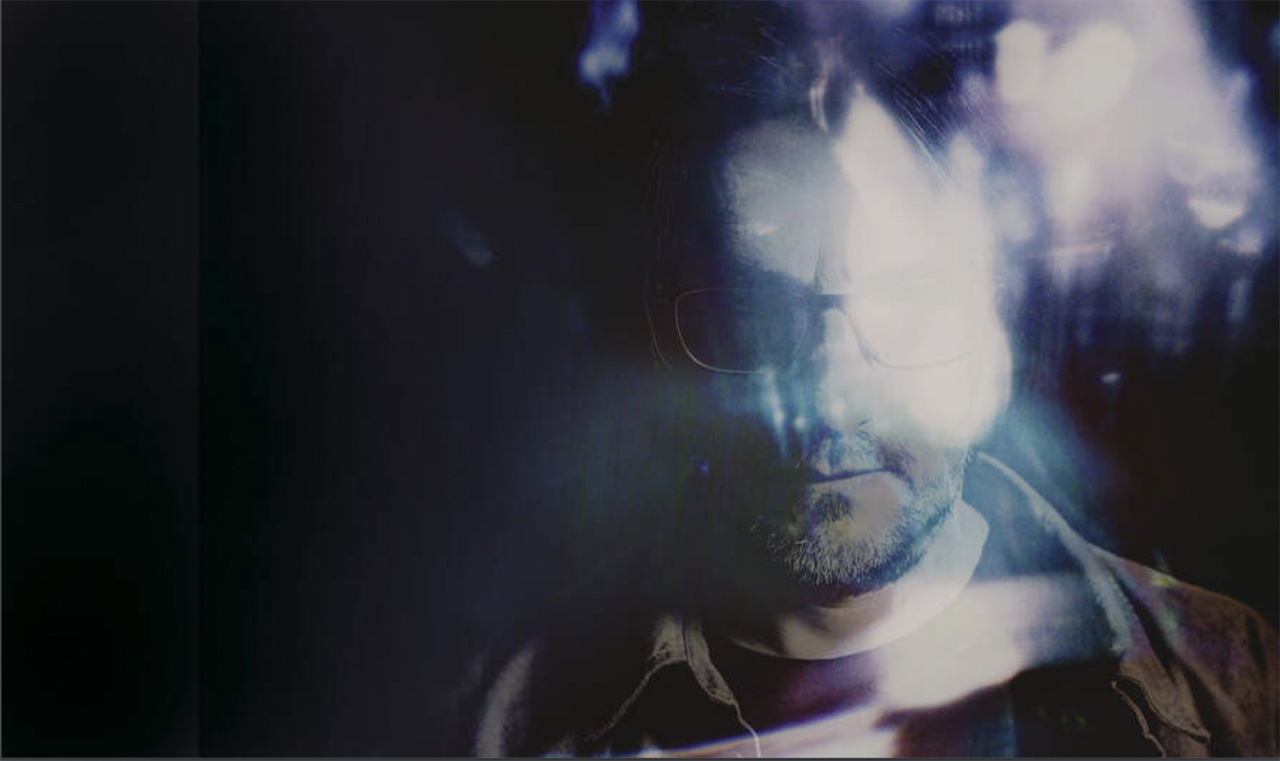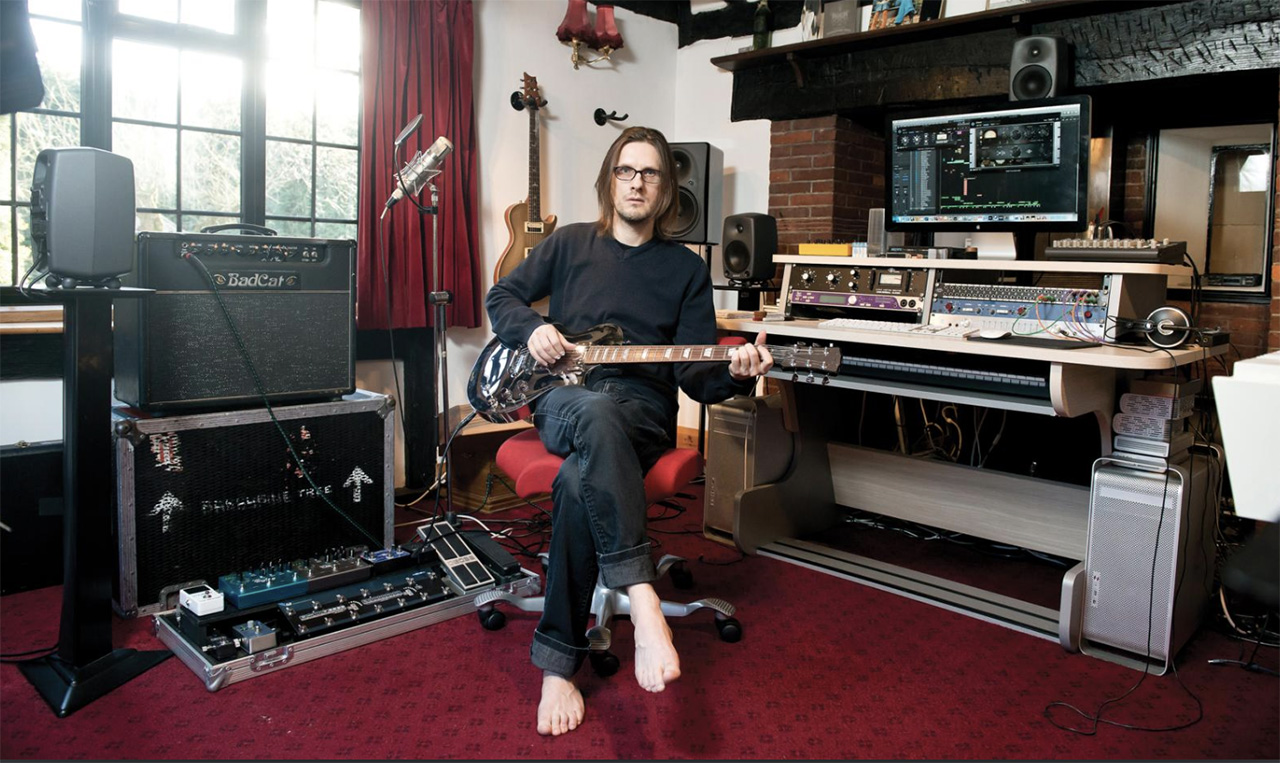“There’s stuff that’s quite ugly for the sake of being ugly and quite noisy for the sake of being noisy… I find myself almost talking people out of it”: What Steven Wilson knows – and doesn’t know – about his new Bass Communion album

On his first Bass Communion album in 12 years, Steven Wilson has pushed the boundaries of progressive music with what could only be described as a experimental noise record. The Itself Of Itself finds him taking inspiration from avant-garde composers and experimenting with studio sounds.
“Even by Bass Communion standards this is a pretty confrontational record.” Steven Wilson reclines on a sofa in his north London home and seeks to explain exactly what Bass Communion is. How he makes the sounds that make up this project’s latest album, The Itself Of Itself. Where the ideas come from. And just what ambient drone noise music is anyway: is it even music at all?
It’s a sometimes uncomfortable record – he’s right – but it’s also fascinating. Veering into territory more commonly occupied by the likes of Sunn O))) and Earth in today’s musical sphere, and previously by Robert Fripp and Brian Eno in the 70s, The Raven That Refused To Sing… or The Future Bites, this is not.
“That’s why it’s called The Itself Of Itself. Because it is what it is,” Wilson says matter-of-factly. “It’s unapologetically what it is.” Unlike 2011’s Cenotaph, whose four titular movements contained a sonic thread – that central throbbing hum – onto which the listener could grab hold to follow where the sound went, The Itself Of Itself’s seven tracks veer wildly from the self-explanatory A Study For Tape Hiss And Other Studio Artefacts through the exploration of radio static in Blackmail to the almost (we stress, almost) calming ambience of Apparition 3.
It’s at once an intriguing listen and a wholly disturbing one as well. There are times, not least in the title track and the 13-minute Bruise, where the listener is drawn in with the initial soundscape, only to feel almost repulsed by a starkly corrosive climax. On the title track the very aural structure dissolves despairingly, while the journey Bruise takes you on ends in a squall of disquieting crackle. In his Prog review, Jeremy Allen suggested the best way to listen was “in a spare hour where nothing is happening.” Perhaps leave the light on too.

“I’d love to tell you that it’s all come from nowhere, but it hasn’t,” Wilson reflects. “I would go down to my local library, back in the days when libraries had records, and take out records by people like [German composer and the father of electronic music] Karlheinz Stockhausen and [Italian composer noted for his experimentation with electronics] Luciano Berio. Serious classical stuff. A lot of that music starts from the premise of an idea, a concept.
“One of Stockhausen’s things was a piece from the mid-60s called Hymnen, where he took recordings of all the national anthems around the world and made a piece of music by processing them. I’ve always liked conceptual things like that. Another piece he had was called Carré, where he had an orchestra in each corner of the auditorium and he would pass sound. Surround sound, in the 1950s. Amazing!
Even people who don’t recognise it as music have an emotional response to pure texture
“So I was always fascinated with great conceptualists like that. And there was also a fascination where you take an idea as a starting point for music. Not a melody, not a rhythm, not a harmony: an idea. For a long time I’ve been really in love with the idea of audio artefacts that act as sound. Tape hiss, warble, saturation, dropouts. And one of my favourite digital plug-ins is one that emulates cassette anomalies. You can choose the brand of tape, how many times it’s been taped over, the age of the tape, dropouts, whatever. And I like it because it gives character to things that are a bit clinical otherwise.
“I got to the point where I found I was enjoying adding things like tape hiss and warble to sounds just to give them character. One day I thought, ‘Wouldn’t it be fun to create a piece of music taking tape hiss as a starting point?’ Because it has lots of different varieties – an old cassette, a new cassette, a metal cassette, an analogue tape. It’s very much in the tradition of experimental avant-garde conceptual art. Think of it in the same way as Rothko painting just using one colour. You deliberately restrict yourself to a very small palette of sound to create some music out of.”

In searching for a link between what many Prog readers listen to and something that might sound like something a lab technician has created, we were drawn back to hearing Tangerine Dream’s fourth album, 1973’s Atem. Well-versed in the more melodic soundscapes of later 70s albums such as Phaedra, Rubycon and Stratosfear, the band’s earlier, more exploratory sound was a harsh listen.
“One of my favourite albums of all time, Atem,” Wilson says with a smile. “I think that a thing that a lot of people who listen to rock music have a problem with is that if you take away melody, rhythm and harmony, they’ll say, ‘That isn’t music at all.’ And yet, if you sit down to watch a horror movie, very often your emotional response to the movie is being… you’re processing the visuals you see, also hearing these drones, and it gives you this feeling of dread in the pit of your stomach. Even people who don’t recognise that kind of thing as music in a recreational sense do have an emotional response to pure texture.
Bass Communion also becomes research and development for the rock albums
“A lot of the appeal of Tangerine Dream was to do with texture and sound on those early records. They turned into something more layered and more progressive. Edgar Froese started playing guitar so there’s more recognisable timbres and sounds. But you go back to the beginning and you’re like, ‘What the hell is that?!’”
Tangerine Dream were, of course, a collective; and although they took a more ambient approach later, they were far removed from the music Wilson creates with Bass Communion. How, though, does he actually set about creating what ends up on BC albums? Is it a case of just walking around, hearing something and wondering what he can do with it?

“Pretty much,” he says with a nod. “The title track is this piece I played on the Mellotron. It was quite nice – but I thought, ‘It’s not interesting enough.’ I spent a long time trying to twist it into something more engaging. I was adding more and more layers of grime and dirt and lo-fi until it sounded like something – to me –fascinating, eerie, creaky, and a bit spooky. Sometimes I think it’s a question of taking something and trying to make it sound more unique, more engaging.”
Does he actively sit down and focus on writing for a Bass Communion record? “I think, because it’s such a different approach, I know when I’m writing for Bass Communion,” he says. “But that doesn’t mean that there isn’t a sense of cross-fertilisation going on. Because in some sense, Bass Communion also becomes research and development for the rock albums, sound treatments, textures, and a lot of stuff. And it is a lot of stuff: there are elements of things that I’ve created in Bass Communion that I’ve retold in the rock albums. There’s a lot of discoveries that go on. ‘Oh, I can do that with that sound,’ and, ‘That’s an interesting sound.’ So there is definitely a crossover.”
These ASMR videos online are supposed to relax you… I can’t do it – It’s like hell to me
Wilson’s wife Rotem is at work in the adjoining kitchen, preparing for one of their daughter’s birthdays the following day. She graciously allows us to sample the odd sweet treat destined for the party; which causes the family dogs, Bowie and Lenny, to sit expectantly at our feet, eyes longingly fixed on the pastries. Given their close proximity to both Wilson’s studio and music room – which houses his formidable record collection, what – Prog wonders, do his daughters make of Bass Communion?
“The girls have heard a lot of music that would be in that tradition,” Wilson states. “Our eldest listens to stuff like Japanese noise music. She loves low frequency oscillation and electronic stuff. While they don’t necessarily like it or listen to it by choice, I think when they grow up, it’s not going to be something that they’re going to listen to and say, ‘That’s crap – that’s not music at all.’ At least they’re going to understand that it has some value as art.”
“There’s the trend of listening to the texture of sound on TikTok,” Rotem interjects. “It could be a chewing sound or whispering. They listen to textures. It’s massive.”

“Oh yeah, ASMR. Have you heard of that?” Wilson asks. Autonomous Sensory Meridian Response is the term used to describe the relaxing sensation some people feel as a result of listening to certain sounds. In recent years there’s been a large increase in the amount of online content containing ASMR ‘trigger’ sounds that are intended to promote relaxation.
“It’s basically YouTube videos with the sound of rustling paper or chewing; all these videos online that are supposed to relax you and create less anxiety. And apparently, it really does work. I can’t do it,” he exclaims, looking at Prog aghast. “It’s like hell to me.”
So which of Dad’s music is their favourite? “Steven’s solo stuff,” Rotem replies. “Because they grew up in this kind of household, they’re so much more exposed to sounds of real guitars and real drums. So they really like the rocky bits. They like the dark rock’n’roll. They also love Taylor Swift and Billie Eilish. But if they had to choose I think they’d go with the really heavy stuff.”
I think a lot of it also comes from the second record of Ummagumma
Outside of his immediate family, Wilson isn’t entirely certain who the Bass Communion audience really is. “This is partly true of everything I’ve ever done,” he ponders. “I do it in a very indulgent, selfish way. But it’s also true to say that Bass Communion itself has moved further and further away from melodic sounds. The earlier sounds were more meditative records. You could put it on in the background. There’s stuff on this record that’s quite ugly for the sake of being ugly and quite noisy for the sake of being noisy. I don’t really know. I find myself almost talking people out of it.”
He’s not lying – our initial request to interview him met with an email that read: “You really want to talk to me about this project for Prog? Just checking as the new album is basically pretty much noise.” He reflects: “That’s the Trojan Horse thing. If it wasn’t me doing this music, you probably wouldn’t give it a second glance. Or be in a position to hear it.
“It’s like you mentioned earlier: you recognise the reference points when you listen to one of my songs. But you’re not so sure when you listen to this. In that sense it’s truly exploratory music, like the piece about tape hiss. I asked myself how I could make tape hiss into something fascinating and beautiful. And I also wondered if you had to be someone like me – someone who had a nostalgia for that anyway. And if you don’t have a nostalgia for cassettes and that sound, maybe it would be completely irrelevant to you. I don’t know.”
As we say our goodbyes, Wilson pauses, struck by thought. “Coming back to your earlier question of where it comes from, I think a lot of it also comes from the second record of Ummagumma. Being a Floyd fan early on and hearing that record when I was maybe 11 or 12 blew my mind. I know a lot of Floyd fans find that unlistenable. To me it was magical.”

